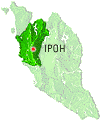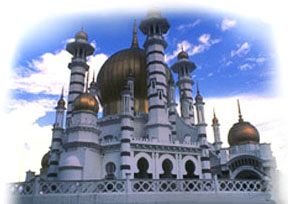![]() Johor
Johor
![]() Malacca
Malacca
![]() Negeri Sembilan
Negeri Sembilan
![]() Selangor
Selangor
![]() Perak
Perak
![]() Kedah
Kedah
![]() Perlis
Perlis
![]() Pahang
Pahang
![]() Terengganu
Terengganu
![]() Kelantan
Kelantan
![]() Penang
Penang
![]() Sabah
Sabah
![]() Sarawak
Sarawak
![]() Kuala Lumpur
Kuala Lumpur
![]() Labuan
Labuan
![]() Putrajaya
Putrajaya

 Like Kelantan and Pahang, Perak is a state that is defined by the course of its
namesake river. Perak's population is about two million. Until
the nineteenth century, Perak's people were concentrated along
the Perak River, and the chief city was riverside Kuala Kangsar.
However, the discovery of wondrously rich tin deposits in
surrounding valleys lead to the establishment of and transfer of
the capital to Taiping and, later, Ipoh. The tin mines around
Ipoh are reputedly the richest in the world, and it is no
surprise that the city has expanded steadily from the time the
mines were discovered in the nineteenth century. Today, Ipoh is
one of Malaysia's larger cities, with a population of about half
a million people.
Like Kelantan and Pahang, Perak is a state that is defined by the course of its
namesake river. Perak's population is about two million. Until
the nineteenth century, Perak's people were concentrated along
the Perak River, and the chief city was riverside Kuala Kangsar.
However, the discovery of wondrously rich tin deposits in
surrounding valleys lead to the establishment of and transfer of
the capital to Taiping and, later, Ipoh. The tin mines around
Ipoh are reputedly the richest in the world, and it is no
surprise that the city has expanded steadily from the time the
mines were discovered in the nineteenth century. Today, Ipoh is
one of Malaysia's larger cities, with a population of about half
a million people.

Perak covers an area of 21,000 square kilometers, making it the second largest state in Peninsular Malaysia (Pahang is larger). The state is situated along Malaysia's western coast at the northern approach to the Strait of Malacca. It extends deep into the peninsula, with its eastern border marked by mountains of the Main Range.
Early Perak kingdoms existed in the settlements of Dinding, Bruas and Manjung. However, the origin of the present sultanate is credited to the eldest son of Melaka's last sultan, Sultan Muzaffar. Perak was constantly menaced by regional powers. The Achinese plundered the state in the 16th century, while the Dutch in 1641 tried to establish a monopoly on Perak's tin trade by building a fort on Pangkor Island. The Bugis and Siamese posed further threats in the 18th century.
Among all the external influences, the Siamese presented the biggest threat. Thrust into the role of a vassal state of Siam, the Kedah sultanate was forced to depose the Sultan of Perak and to ensure more compliance to Siamese rule by the Perak kingdom. Treaties drawn up between the British and the Siamese accorded some degree of protection from attacks and infiltrations. Internally, Perak was embroiled in a throne succession war in the 1870s between Raja Yusuf, Raja Ismail and Raja Abdullah. Adding to the air of strife was the rivalry between factions of the Chinese.
By the mid nineteenth century the Chinese presence in Malaya was considerable, with immigration being spurred by the growing tin industry. With its abundant cache of tin, Perak was one of the favored destinations for incoming workers. This immigration also brought with the people from mainland China the social order of secret societies. By the 1870s, there was an ongoing dispute between the rival Chinese clans of Ghee Hin and Hai San. This led to British intervention in order to protect their interests in Perak. The Malay chiefs and clan leaders were summoned to a conference on Pangkor Island in 1874. Under the Pangkor Engagement, Abdullah was conferred the sultanate and J.W.W. Birch appointed as the first British Resident.
Disgruntled by the forceful implementation of British interest with little regard for their own, a number of Malay leaders planned the assassination of Birch in 1875. Several Malay nobles such as Sultan Abdullah, Dato' Maharajalela, Ngah Ibrahim and Dato' Sagor were implicated in the plot and were subsequently sentenced to death or exiled. In 1896, Perak became a Federated Malay State, which lasted until the Japanese invasion.
When the Japanese withdrew in September 1945, the British Military Administration took over. The British in London formed the Malayan Peninsula Planning Unit in 1943, and on 10 October 1945, the Malayan Union scheme was laid out before the British Parliament. A day later, Sir Harold MacMichael was sent to the Malayan Peninsula to obtain the agreement of the Malay Rulers. According to this agreement, Pulau Pinang, Melaka and nine other Malay states were united under the Malayan Union. Malay opposition derailed the Malayan Union plan, and the Malays under Dato' Onn Jaafar's leadership formed the United Malays National Organisation (UMNO) on 11 May 1946. The Malay Federation was founded on 1 February 1948, the first step towards independence, and on 31 August 1957, independence was achieved.
Area
21,005 square km
State Capital
Ipoh
Royal Town
Kuala Kangsar
Administrative Divisions
9 (Batang Padang, Manjung, Hilir Perak, Kerian, Kinta, Kuala
Kangsar, Larut and Matang, Perak Tengah, Hulu Perak)
Population
2,030,382 (2000)
Breakdown of Races (1994)
Perak
is known for its abundant tin fields and is the principal tin
mining area in Peninsular Malaysia, in addition to various places
of interest. Night markets are great for bargain shopping for
items like handicrafts, local fruits, clothes and household
utensils. Waterfalls, caves, museums, parks and historical
landmarks are other tourist attractions.
Towns & Infrastructure
Islands & Beaches
Nature
![]() States
States
![]() Tourism
Tourism
![]() National Symbols
National Symbols
![]() History
History
![]() Geography
Geography
![]() Flora & Fauna
Flora & Fauna
![]() Economy
Economy
![]() Culture
Culture
![]() Festivals
Festivals
![]() Transportation
Transportation
![]() Accommodation
Accommodation
![]() Foreign Exchange
Foreign Exchange
![]() Food
Food
![]() Fruits
Fruits